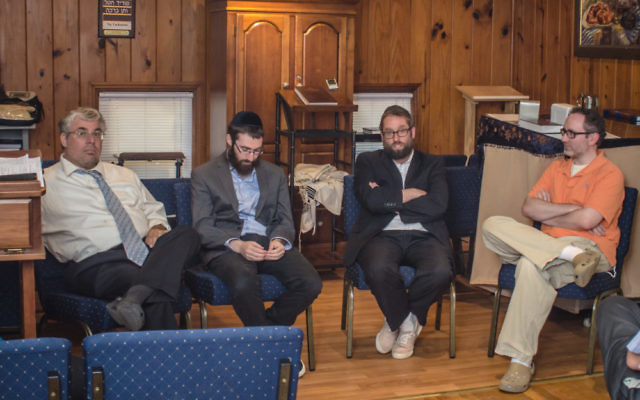Orthodox Rabbis Weigh Unity vs. Uniqueness
By Eli Gray
For the Orthodox community, Tisha B’Av is a day on which the hard questions of life are addressed, one of the toughest being the topic of Jewish unity. So the New Toco Shul used the waning hours of the day Sunday, Aug. 14, to hold a panel on Jewish unity.
Rabbi Don Seeman, a professor at Emory University, Rabbi Yale New, the executive director of the Friendship Circle, and Rabbi Naftali Estreicher, rebbe at Yeshiva Ohr Yisrael, discussed whether “Orthodoxy is better off united, divided or something else,” moderated by Yacov Freedman.

(From left) Rabbis Don Seeman, Yale New and Naftali Estreicher join Yacov Freedman for a discussion of Orthodox unity at New Toco Shul.
Rabbi Estreicher stressed that the Torah needs to remain the central focus to ensure that Orthodox Jews are united by the same goal. That being said, he added that each individual needs to recognize his or her own uniqueness and must not suppress uniqueness on the count of unity.
Rabbi New said true unity involves different people with different ideas combining to create a brighter and greater picture.
Rabbi Seeman prefaced his remarks by saying we need to remember that unity is not binary; the answer to the question is not a simple yes or no.
“Unity, for what purpose?” he said. “There are going to be people on the inside and people on the outside for different purposes, and the difficulty is to sensitively figure out what those purposes are. And we get into a lot of trouble this way. We exclude people when it’s not necessary and include when not necessary. There is no ironclad answer how to do it.”
The panelists addressed their lines in the sand — the point at which they would say, “No, I will not cross this line for the sake of unity.”
Rabbi Seeman said boundaries are vital to a community’s existence but must be examined to ensure they don’t exclude people we are trying to include.
Rabbi New brought up the issue of differing standards in regard to conversion. He pointed out that lines in other areas may be of a communal rather than a halachic nature, though such communal standards often are what make the community.
Rabbi Estreicher’s approach involves deciding whether the issue will lead to something that’s against the Torah, even indirectly, in which case there is nothing to talk about.
The moderator closed the discussion by asking whether there is a particular area in Orthodoxy in which unity is strained, and if so, what can be done about it.
For Rabbis New and Estreicher, the importance of sharing and respecting different ideas while evaluating their suitability for the community is an area that can use some attention.
Rabbi Seeman said gender roles — what’s appropriate for women to do in the Orthodox community —can cause divisions.
“There is not currently a sophisticated conversation taking place, but rather both sides seem to be shouting at one another,” he said. “While we do have to draw boundaries, we need to be careful to make clear arguments based on sources in halacha rather than just following our gut.”
He added, “When it comes to matters of policy, I’m much more skeptical of reading people into and out of the community.”




comments